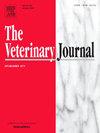2023年,大型兽医实践网络中狗和猫常见情况的抗菌药物分配
IF 3.1
2区 农林科学
Q1 VETERINARY SCIENCES
引用次数: 0
摘要
了解抗菌素的使用是抗菌素管理的核心组成部分。本研究旨在评估在美国大型诊所网络的兽医诊所提供的狗和猫的常见临床情况下的抗菌药物分配。在831,017次就诊中,对702,576只狗(85% %)和128,441只猫(15% %)开具了抗菌剂处方。头孢多肟( = 203,145,29 %)、阿莫西林-克拉维酸酯(154,779,22 %)和甲硝唑(150,830,21 %)是犬类中最常用的抗菌素,猫类中以头孢维素(55,579,43 %)和阿莫西林-克拉维酸酯(44,857,35 %)为主。在犬类中,被WHO MIA清单分类为最高优先级极其重要(HPCIA)的药物占已分配药物的39% %,而被分类为高度重要(HIA)的药物占61% %。在猫中,HPCIA药物占分配药物的46% %,HIA药物占54 %。犬类药物选择与所选治疗指南的一致性为76 %(30,562/40,375),猫类药物选择与所选治疗指南的一致性为57 %(12,810/22,644)。对狗和猫来说,所有10种最常见疾病的药物选择模式都存在地区差异。虽然没有单一的指标或数据来源能够全面了解抗菌素使用情况,但这些数据为评估抗菌素使用做法提供了基础,并为制定改善抗菌素使用做法的干预措施提供了见解和基线数据。本文章由计算机程序翻译,如有差异,请以英文原文为准。
Antimicrobial dispensing for common conditions in dogs and cats at a large veterinary practice network, 2023
Understanding antimicrobial use is a core component of antimicrobial stewardship. This study aimed to assess antimicrobial dispensing for common clinical conditions in dogs and cats presented to veterinary clinics belonging to a large clinic network in the USA. Antimicrobials were prescribed for 831,017 patient visits, to 702,576 (85 %) dogs and 128,441 (15 %) cats. Cefpodoxime (n = 203,145, 29 %), amoxicillin-clavulanate (154,779, 22 %) and metronidazole (150,830, 21 %) were the most commonly dispensed antimicrobials in dogs, while cefovecin (55,579, 43 %) and amoxicillin-clavulanate (44,857, 35 %) predominated in cats. In dogs, drugs classified by the WHO MIA List as highest priority critically important (HPCIA) accounted for 39 % of drugs dispensed, while those classified as highly important (HIA) accounted for 61 %. In cats, HPCIA drugs accounted for 46 % of drugs dispensed while HIA drugs accounted for 54 %. Consistency of drug selection with selected treatment guidelines was 76 % (30,562/40,375) for dogs and 57 % (12,810/22,644) for cats. There were regional differences in drug selection patterns for all of the 10 most common diseases, for both dogs and cats. While no single metric or data source provides a full understanding of antimicrobial use, these data provide the foundation for assessment of antimicrobial use practices and provide insight and baseline data for development of interventions to improve antimicrobial use practices.
求助全文
通过发布文献求助,成功后即可免费获取论文全文。
去求助
来源期刊

Veterinary journal
农林科学-兽医学
CiteScore
4.10
自引率
4.50%
发文量
79
审稿时长
40 days
期刊介绍:
The Veterinary Journal (established 1875) publishes worldwide contributions on all aspects of veterinary science and its related subjects. It provides regular book reviews and a short communications section. The journal regularly commissions topical reviews and commentaries on features of major importance. Research areas include infectious diseases, applied biochemistry, parasitology, endocrinology, microbiology, immunology, pathology, pharmacology, physiology, molecular biology, immunogenetics, surgery, ophthalmology, dermatology and oncology.
 求助内容:
求助内容: 应助结果提醒方式:
应助结果提醒方式:


